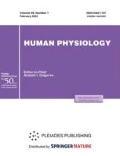Abstract
The average diurnal blood pressure profiles (DBPPs) were studied in subjects working at different hours of the day, including nighttime. The DBPPs and the curve levels in winter and in summer were compared. The study material included more than 497 000 prework blood pressure (BP) measurement points in 30 566 locomotive drivers. It was found that the average DBPP of the subjects working at different hours of the day is of a markedly nondipper type; i.e., despite night wakefulness, the BP was lower at night but not as low as that of those sleeping at night. In the cohort studied, the shapes of the DBPP curve did not differ in winter and in summer; however, the BP levels in winter were significantly higher.
Similar content being viewed by others
References
Anisimov, V.N., Melatonin. Rol’ v organizme, primenenie v klinike (Melatonin: The Role in the Body, Use in the Clinical Setting), St. Petersburg, 2007.
Arushanyan, E.B., Unikal’nyi melatonin (Unique Melatonin), Stavropol’, 2006.
Suwazono, Y., Dochi, M., Sakata, K., et al., Shift Work Is a Risk Factor for Increased Blood Pressure in Japanese Men, Hypertension, 2008, vol. 52, p. 581.
Ohira, T., Tanigawa, T., Iso, H., et al., Effects of Shift Work in 24-Hour Ambulatory Blood Pressure and Its Variability among Japanese Workers, Scand. J. Work Environ. Health, 2000, vol. 26(5), p. 421.
Barbarash, O.L., Basheva, L.I., Smakotina, S.A., et al., Cardiovascular Risk Factors in Doctors of Different Specialties, Kardiologiya, 2008, no. 7, p. 52.
Su, T.E., Lin, L.Y., Baker, D., et al., Elevated Blood Pressure, Decreased Heart Rate Variability and Incomplete Blood Pressure Recovery after a 12-Hour Night Shift Work, J. Occup. Health, 2008, vol. 50(5), p. 380.
Lo, S.H., Lin, L.Y., Chang, Y.Y., et al., Working the Night Shift Causes Increased Vascular Stress and Delayed Recovery in Young Women, Chronobiol. Int., 2010, vol. 27(7), p. 1454.
Khromtsova, O.M., Characteristic Features of Seasonal Blood Pressure Rhythms in Healthy Subjects and in Hypertension, Ural. Med. Zh., 2009, vol. 9(63), p. 11.
O’Brien, E., Sheridan, J., and O’Malley, K., Dippers and Nondippers, Lancet, 1988, no. 2, p. 397.
Chazova, I.E. and Ratova, L.G., Role of 24-Hour Monitoring of Blood Pressure in the Assessment of the Efficacy of Antihypertensive Therapy (The Results of 24-Hour Monitoring of Blood Pressure in the KLIP-AKKShchRD), Sistemnye gipertenzii (Systemic Hypertension), 2007, TO9(1). http://old.consilium-medicum.com/media/system/07_01/18.shtml.
Author information
Authors and Affiliations
Additional information
Original Russian Text ¢ O.Yu. At’kov, 2012, published in Fiziologiya Cheloveka, 2012, Vol. 38, No. 1, pp. 88–91.
Rights and permissions
About this article
Cite this article
At’kov, O.Y. Blood pressure in night shift workers: circadian rhythms and levels and their seasonal differences. Hum Physiol 38, 73–76 (2012). https://doi.org/10.1134/S0362119712010021
Received:
Published:
Issue Date:
DOI: https://doi.org/10.1134/S0362119712010021




